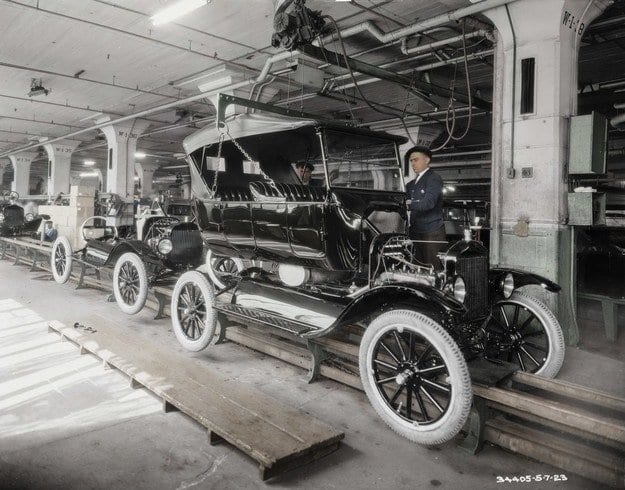
Who moved the conveyor

Production lines are working again, and this is a reason to remember their creator
October 7, 1913 in one of the halls of the Highland Park automobile plant. Ford launches the world's first car production line. This material is an expression of respect for the innovative manufacturing processes created by Henry Ford, who revolutionized the automotive industry.
The organization of car production today is a very complex process. Assembly of a car at the factory is 15% of the total production process. The remaining 85 percent involves the production of each of the more than ten thousand parts and their pre-assembly in about 100 of the most important production units, which are then sent to the production line. The latter is carried out by a huge number of suppliers (for example, 40 in VW) who carry out a very complex and very efficient coordinated chain of production processes, including accurate and timely deliveries (the so-called just-in-time process) of components and suppliers. first and second level. The development of each model is only part of how it reaches consumers. A huge number of engineers are involved in organizing the production process that takes place in a parallel universe, including actions from coordinating the supply of components to their physical assembly in a factory with the help of people and robots.
The development of the manufacturing process is due to almost 110 years of evolution, but Henry Ford made the greatest contribution to its creation. It is true that when he created the current organization, the Ford Model T that began to be installed was extremely simple, and its components were almost entirely produced by the company itself, but every field of science has its pioneers who laid the foundations almost blindly. Henry Ford will forever go down in history as the man who motorized America - long before it happened in Europe - by combining a simple and reliable car with efficient production that lowered costs.
Pioneer
Henry Ford always believed that human progress would be driven by natural economic development based on production, and he hated all speculative forms of profit. Unsurprisingly, the opponent of such economic behavior will be a maximalist, and the pursuit of efficiency and the creation of a production line is part of his success story.
In the early years of the automotive industry, automobiles were carefully assembled by skilled and usually talented engineers in humble artisan workshops. To this end, they use machines known hitherto used to assemble carriages and bicycles. In general, the machine is in a static position, and workers and parts move along it. Presses, drills, welding machines are grouped in different places, and individual finished products and components are assembled on workbenches, and then must “travel” from one place to another and to the car itself.
Henry Ford's name cannot be found among the pioneers of the auto industry. But it was through the creative combination of Henry Ford's unique management, organizational, and design abilities that the automobile became a mass phenomenon and motorized the American nation. It owes its privileged status to him and dozens of other progressive-minded Americans, and the early twentieth-century Model T lent a tangible character to today's cliché that a car can be a necessity, not necessarily a luxury. The car that plays the main role in this, the Model T, does not shine with anything special, except for incredible lightness and strength. However, Henry Ford's methods for producing this car so efficiently became the basis of a revolutionary new technical ideology.
By 1900, there were more than 300 companies manufacturing vehicles with internal combustion engines in the world, and the leading countries in this business were the USA, France, Germany, England, Italy, Belgium, Austria, and Switzerland. At that time, the oil industry was developing at a very fast pace, and now America was not only a major producer of black gold, but also a technological leader in this area. This creates a sufficiently stable alloy to discard the development of American industry.
American people car
Somewhere in this turmoil, the name of Henry Ford appears. Faced with opposition from his first company’s partners for his desire to produce a practical, reliable, cheap and production car, in 1903 he founded his own company, which he called Ford Motor Company. Ford built a car to win the race, put an eight-day cyclist behind the wheel, and easily raised $ 100 from benevolent investors for his startup; the Dodge brothers agree to supply him with engines. In 000, he was ready with his first production car, which he named the Ford Model A. After launching several expensive models, he decided to go back to his original idea of creating a popular car. By purchasing part of the shares of its shareholders, he acquires enough financial capabilities and positions in the company to start his own production.
Ford is a rare bird even for the liberal understanding of Americans. Ticklish, ambitious, he had his own ideas about the automobile business, which at that time differed significantly from the views of his competitors. In the winter of 1906, he rented a room in his Detroit plant and spent two years with his colleagues designing and planning the production of the Model T. The car that finally came into existence as a result of the secret work of the Ford team changed. image of America forever. For $825, a Model T buyer can get a car weighing just 550kg with a relatively powerful 20hp four-cylinder engine that's easy to drive thanks to a pedal-operated two-speed planetary transmission. Simple, reliable and comfortable, a small car delights people. The Model T was also the first American car to be made from lighter vanadium steel, which was unknown to other overseas manufacturers at the time. Ford brought this method from Europe, where it was used to make luxury limousines.
In the early years, the Model T was produced like all other cars. However, the growing interest in it and the growing demand prompted Ford to start building a new plant, as well as organize a more efficient production system. In principle, he seeks not to look for a loan, but to finance his undertakings from his own reserves. The success of the car allowed him to invest in the creation of a unique plant in Highland Park, named by Rockefeller himself, whose refineries are the criterion for the most modern production "the industrial miracle of its time." Ford's goal is to make the car as light and simple as possible, and buying new parts is more profitable than repairing them. A simple model T consists of an engine with a gearbox, a simple frame and body, and two elementary axles.
7th of October 1913
In the early years, production at this four-storey plant was organized from the top down. It "descends" from the fourth floor (where the frame is assembled) to the third floor, where the workers put engines and bridges. After the cycle ends on the second floor, new cars drive up the final ramp past the offices on the first floor. Production rose sharply in each of the three years, from 19 in 000 to 1910 in 34, reaching an impressive 000 units in 1911. And this is just the beginning, because Ford is already threatening to "democratize the car."
Thinking about how to create a more efficient production, he accidentally ends up in a slaughterhouse, where he watches a mobile line for cutting beef. The carcass meat is hung on hooks moving along the rails, and in different places of the abattoir, butchers separate it until nothing remains.
Then an idea came to his mind, and Ford decided to reverse the process. In other words, this means creating a main moving production line, which is powered by additional lines connected to it by agreement. Time matters - any delay in any of the peripheral elements will slow down the main one.
On October 7, 1913, the Ford team created a simple assembly line for final assembly in a large factory hall, including a winch and cable. On this day, 140 workers lined up about 50 meters of the production line, and the machine was hauled across the floor by a winch. At each workstation, a part of the structure is added to it in a strictly defined order. Even with this innovation, the final assembly process is reduced from over 12 hours to less than three. Engineers take on the task of perfecting the conveyor principle. They experiment with all sorts of options - with sleds, drum tracks, conveyor belts, towing chassis on a cable and implement hundreds of other ideas. In the end, in early January 1914, Ford built the so-called endless chain conveyor, along which the chassis moved to the workers. Three months later, the man high system was created, in which all parts and the conveyor belt are located at waist level and organized so that workers can do their job without moving their legs.
The result of a brilliant idea
As a result, already in 1914, 13 workers of the Ford Motor Company assembled 260 cars in numbers and words. For comparison, in the rest of the automotive industry, 720 workers produce 66 cars. In 350, Ford Motor Company produced 286 Model Ts, 770 each. In 1912, Model T production increased to 82 and the price fell to $388.
Many accuse Ford of turning people into machines, but for industrialists the picture is altogether different. Extremely effective management and development allows those who are able to participate in the organization of the process, and less educated and undertrained workers - the process itself. To reduce turnover, Ford made a bold decision and in 1914 increased his salary from $2,38 a day to $1914. Between 1916 and 30, at the height of World War I, the company's profits doubled from $60 million to $XNUMX million, unions sought to interfere in Ford's affairs, and its workers became buyers of their products. Their purchases effectively return a portion of the fund's wages, and increased production keeps the fund's value low.
Even in 1921, the Model T held 60% of the new car market. At the time, Ford's only problem was how to produce more of these cars. The construction of a huge high-tech plant begins, which will introduce an even more efficient method of production - the just-in-time process. But that is another story.
Text: Georgy Kolev

